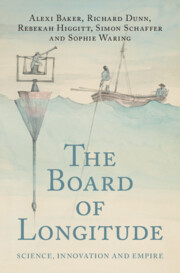Book contents
- The Board of Longitude
- The Board of Longitude
- Copyright page
- Dedication
- Contents
- Figures
- Tables
- Boxes
- Acknowledgements
- Timeline
- Abbreviations
- 1 Introduction
- 2 Sailing the Oceans and Seeking Longitude before 1714
- 3 Launching the Eighteenth-Century Search for Longitude
- 4 The Early Commissioners in Transition
- 5 The Birth of the Board of Longitude
- 6 Time Trials
- 7 Manufacturing the Nautical Almanac
- 8 Managing, Communicating and Judging Longitude after Harrison, 1774–c. 1800
- 9 A Practical Institution Weighed Down by Impractical Proposals?
- 10 What Is an Observatory? From the Metropolis to the Cape
- 11 The Death and Rebirth of the Board of Longitude
- Epilogue
- Book part
- Glossary
- Bibliography
- Index
11 - The Death and Rebirth of the Board of Longitude
Published online by Cambridge University Press: 11 April 2025
- The Board of Longitude
- The Board of Longitude
- Copyright page
- Dedication
- Contents
- Figures
- Tables
- Boxes
- Acknowledgements
- Timeline
- Abbreviations
- 1 Introduction
- 2 Sailing the Oceans and Seeking Longitude before 1714
- 3 Launching the Eighteenth-Century Search for Longitude
- 4 The Early Commissioners in Transition
- 5 The Birth of the Board of Longitude
- 6 Time Trials
- 7 Manufacturing the Nautical Almanac
- 8 Managing, Communicating and Judging Longitude after Harrison, 1774–c. 1800
- 9 A Practical Institution Weighed Down by Impractical Proposals?
- 10 What Is an Observatory? From the Metropolis to the Cape
- 11 The Death and Rebirth of the Board of Longitude
- Epilogue
- Book part
- Glossary
- Bibliography
- Index
Summary
This chapter reinterprets the demise of the Board of Longitude in 1828, which has been seen as resulting from reformist pressure or financial retrenchment. Such accounts underestimate continuation of the Board’s activities, notably managing chronometers, producing the Nautical Almanac and providing scientific advice. Changes were initially driven by Joseph Banks’s interests, notably the appointment of Royal Society fellows and Resident Commissioners including Thomas Young, who became secretary and a key organiser after Banks’s death. Schemes such as rewards for finding the Northwest Passage, improvement of optical glass, determining the figure of the Earth and the foundation of the Cape Observatory, were managed under Young’s aegis. The role of the Admiralty and its Secretaries John Wilson Croker and John Barrow were decisive. The Longitude Act of 1818 brought the Board under Admiralty control, and that of 1828 moved its work into the Admiralty. An Admiralty committee comprising Young and natural philosophers Michael Faraday and Edward Sabine was formed; the Nautical Almanac and chronometer testing remained within the Admiralty’s financial remit.
- Type
- Chapter
- Information
- The Board of LongitudeScience, Innovation and Empire, pp. 252 - 272Publisher: Cambridge University PressPrint publication year: 2025

